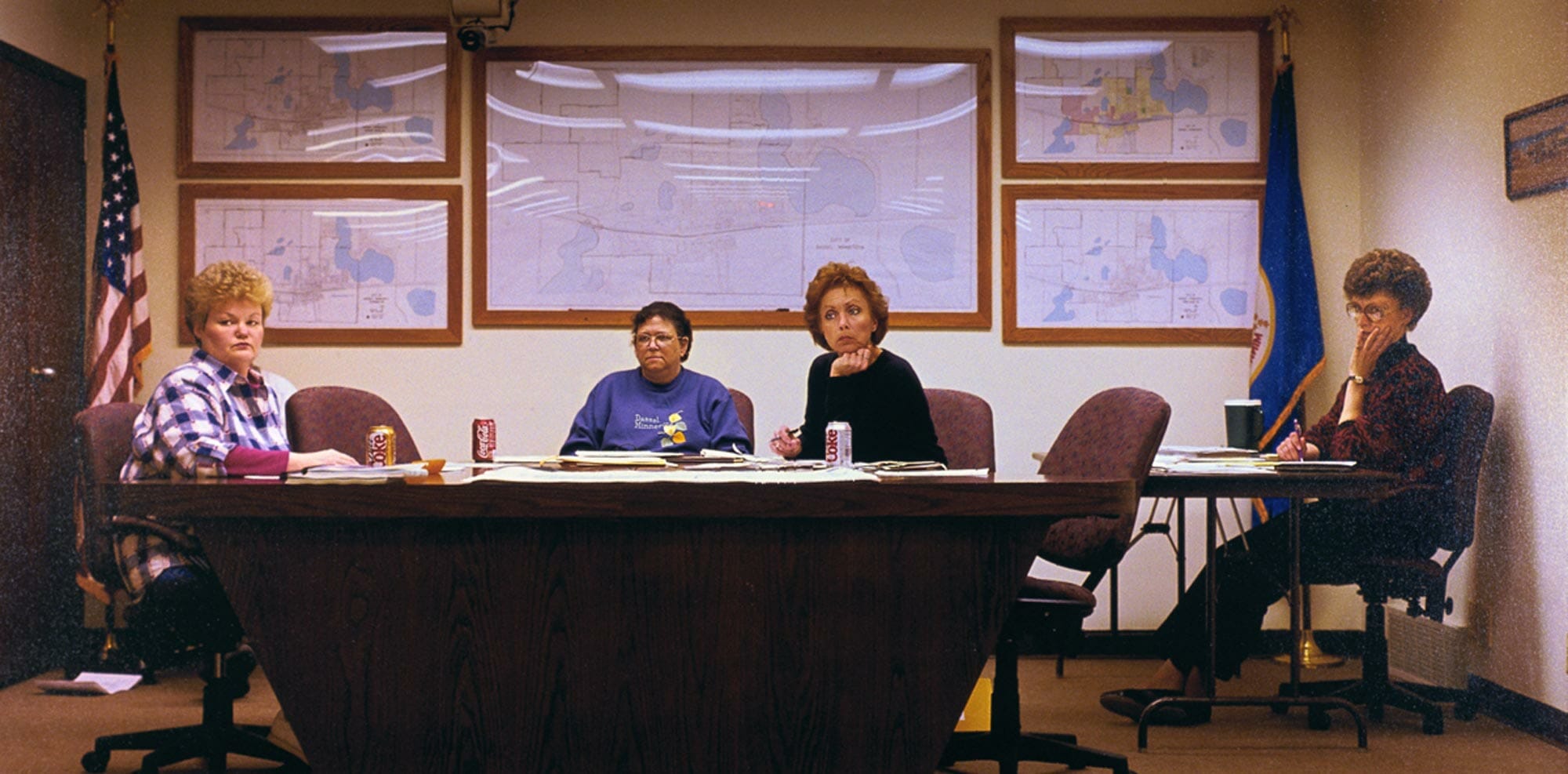
Paul Shambroom
Dassel City Council
Paul Shambroom’s panoramic photograph has the appearance of a seventeenth-century Dutch painting of civic leaders. It is large, thirty-three inches high and sixty-six inches wide. Flags and maps suggest that the photograph was taken in a government meeting; the title confirms this impression, along with noting the population numbers in the community of Dassel, Minnesota, and the names of the town council members and clerk present at the meeting.
The viewer’s vantage point is from the eye-view of a community member who may be attending the council meeting. Three councilwomen sit on the opposite side of a large table and the clerk sits at an auxiliary table in the corner; the council members are apparently focusing on a speaker in the audience. Their questioning, intent expressions and the papers in front of them signify the importance of their work; as elected officials, the councilwomen make decisions that affect everyone in their community.
Dassel City Council is part of Shambroom’s project called Meetings (1999-2005), a series of photographs he took documenting town and city meetings across the United States. Shambroom spent about an hour photographing the Dassel City Council meeting, shooting a total of thirty images. He did not instruct his subjects or alter their environment in any way; he behaved purely as an observer. Using only available light, he captured moments as they occurred.
Shambroom has described his artistic process: “Using a laptop computer, a database of more than 15,000 communities in over thirty states, and mapping software, I plan my daily itinerary according to geography, population, and meeting schedules. After driving several hundred back road miles I pull up to the town meeting hall and there have the privilege of seeing democracy in its purest form as farmers, teachers, and insurance agents conduct the business of their community…Although town council and community meetings are open to the public, the process of governance can still seem somewhat invisible and separate from the lives of ordinary people. [This] photograph emphasizes the theatrical aspects of meetings: There is a cast, a set, an audience, and a program (the agenda). Seating arrangements, clothing, and body language all provide clues to local cultural traits and political dynamics.”
Shambroom used a 4 x 5-inch field camera to produce the color negative for Dassel City Council, Dassel, Minnesota. He then scanned the negative onto his computer where he sharpened the image and adjusted the contrast and color. The final print was made from a higher resolution drum scan, which underwent digital refinement. Finally, he used an inkjet printer to transfer the digital image onto canvas, which was then stretched and varnished. Shambroom’s decision to print the photograph at a large scale links the image to the history of painting and monumentalizes the image, the subjects, and the political work taking place. His ambition, he says, is similar to that of European Salon painters of the eighteenth and nineteenth centuries who recreated important historical events in mural-sized paintings. By evoking the tradition of civic portrait painting, Shambroom has drawn attention to the significance of democratic process as it occurs in small communities.
The Artist
Paul Shambroom
Paul Shambroom was born in 1956 and graduated from the Minneapolis College of Art and Design in 1978 where he studied photography. He is currently on the faculty of the Department of Art at the University of Minnesota, Minneapolis. In addition to his Meetings images like Dassel City Council, Dassel Minnesota, his other explorations of political power in American society include the series Nuclear Weapons (1989-2001) for which he visited sites where missiles are stockpiled. Shambroom has said, “A common impulse in these projects is my quest as one individual to understand and illuminate seemingly overwhelming and abstract power systems.”
Key Ideas
- Art that examines moments of every day democratic process
- Individual photographic imagery as part of a larger series for exploring an idea or theme
- Links between art made with contemporary technology and the methods and subjects of art made in the past
Discussion Questions
- What details do you notice about the site for this town council meeting?
- What choices have the participants made about seating arrangement, clothing, and physical behavior? What information is conveyed by these choices?
- Consider the decisions the artist made, including the vantage point from which the photograph was taken. What ideas does this perspective communicate? What are your thoughts about why the artist chose not to include any people in the rest of the room?
- What ideas does this photograph suggest about the apparatus of power in American democracy? Is a sense of community reflected in this image? In what ways?